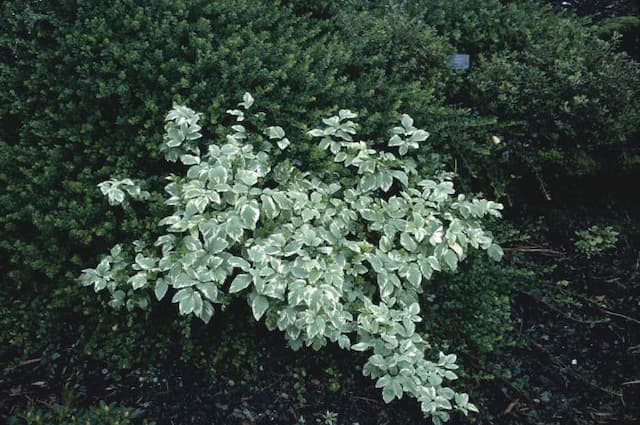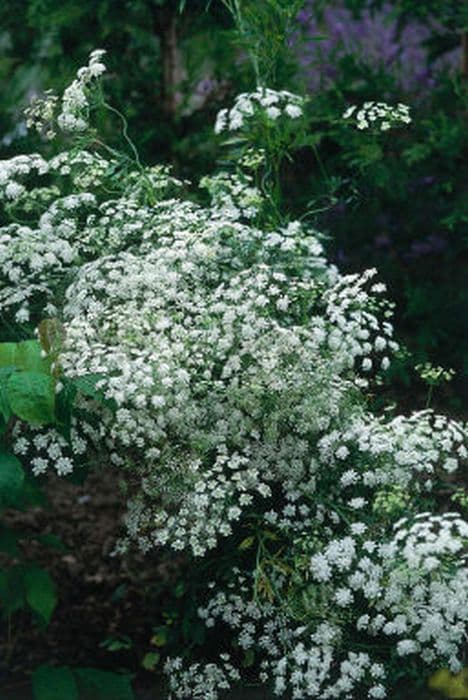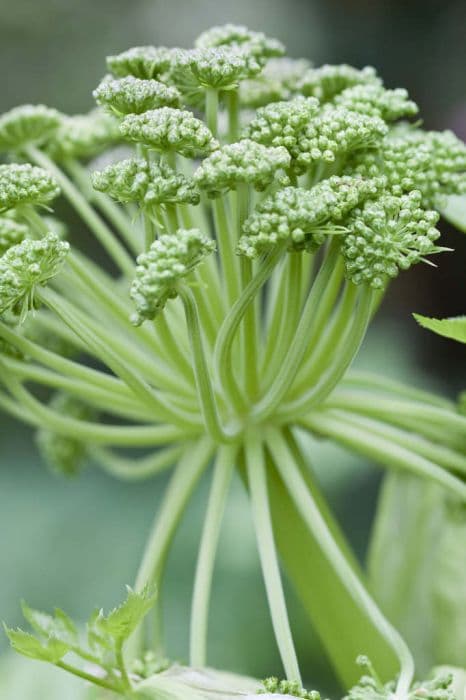Miss Willmott's Ghost Eryngium giganteum 'Silver Ghost'

ABOUT
Eryngium giganteum 'Silver Ghost', commonly known as Miss Willmott's Ghost, is an eye-catching perennial plant with a distinct appearance. Its foliage consists of a rosette of spiny, deeply-lobed, silvery-green leaves that resemble those of a thistle. The leaves are often veined and can have a slightly metallic or glaucous sheen. The most striking feature of Miss Willmott's Ghost is its flower heads, which are large, cone-shaped, and encompassed by a ruff of silvery, spiky bracts. These bracts start off with green hues and gradually transition to a brighter, almost luminous silver as they mature, creating a contrast against the foliage and giving the plant a ghostly appearance that befits its common name. The actual flowers are small and insignificant, and typically a pale color. The plant's overall structure is robust and upright, with numerous branching stems that form a dense clump, creating an architectural and textured look in garden settings. When in bloom, the combination of the silvery bracts and the soft-colored flowers produces a shimmering effect, especially when backlit by early morning or late afternoon sun. The visual impact of Eryngium giganteum 'Silver Ghost' in gardens is further enhanced when placed against a darker background or when grouped with other plants that complement its unique color palette and structure.
About this plant
 Names
NamesFamily
Apiaceae
Synonyms
Miss Willmott's Ghost, Giant Sea Holly
Common names
Eryngium giganteum.
 Toxicity
ToxicityTo humans
Eryngium giganteum 'Silver Ghost,' commonly known as Miss Willmott's Ghost, is not known to be toxic to humans. Most members of the Eryngium genus are safe and even used in traditional medicine or as edible plants. However, it's always prudent to avoid ingesting plants that are not commonly recognized as food, as individual allergies or sensitivities can occur.
To pets
Miss Willmott's Ghost is not known to be toxic to pets. As with humans, pets are unlikely to experience poisoning from ingesting this plant. Despite this general safety, it is always best practice to prevent pets from consuming ornamental plants as they might still cause digestive upset or an allergic reaction in sensitive individuals.
 Characteristics
CharacteristicsLife cycle
Biennials
Foliage type
Deciduous
Color of leaves
Silver
Flower color
Varies
Height
3 feet (91 cm)
Spread
18 inches (45 cm)
Plant type
Herb
Hardiness zones
5
Native area
Caucasus
Benefits
 General Benefits
General Benefits- Aesthetic Appeal: Eryngium giganteum 'Silver Ghost', also known as Miss Willmott's ghost, adds striking architectural form to garden landscapes with its ghostly silver and green coloring.
- Drought Tolerance: This plant is well-suited for xeriscaping due to its ability to withstand periods of drought once established.
- Attracts Pollinators: The flowers of Miss Willmott's ghost attract bees and other pollinators, which are essential for the health of the garden ecosystem.
- Low Maintenance: It requires minimal care and can thrive in poor soil, making it ideal for gardeners looking for low-maintenance plants.
- Deer Resistance: The spiny foliage and stems help deter deer, making it a good option for gardens in areas with high deer populations.
- Seasonal Interest: The plant provides visual interest throughout the growing season, from the early emergence of its basal rosette to its statuesque winter seed heads.
- Unique Cut Flowers: The structurally interesting stems and seed heads make excellent cut flowers for arrangements or can be dried for long-lasting displays.
 Medical Properties
Medical PropertiesThis plant is not used for medical purposes.
 Air-purifying Qualities
Air-purifying QualitiesThis plant is not specifically known for air purifying qualities.
 Other Uses
Other Uses- Eryngium giganteum 'Silver Ghost', commonly known as Sea Holly, can be used in dried floral arrangements, maintaining its structure and color for extended periods.
- Sea Holly can serve as an interesting addition to coastal-themed garden designs due to its spiky texture and silver-blue color reminiscent of the seaside.
- The plant's striking appearance can be used in fashion design, with its dried flowers and bracts incorporated into avant-garde clothing and accessories.
- Sea Holly can be used as a natural barrier in gardens because its spiky foliage deters animals and possibly intruders from crossing into protected areas.
- The plant can act as an accent in xeriscapes, showcasing its ability to thrive in dry conditions while adding visual interest with its unique form.
- Sea Holly can be used in eco-friendly landscaping as it is drought tolerant and can reduce the need for frequent watering once established.
- The architectural quality of Sea Holly makes it suitable for use in modern garden design, complementing minimalist and geometric landscapes.
- As an educational tool, Sea Holly can be used in botanical studies focused on plant adaptations, due to its ability to survive in poor soils and harsh conditions.
- Sea Holly can be used in crafting, particularly in creating botanical prints or as stencils due to the pronounced outline of its leaves and flowers.
- The plant can also serve as a natural dye source, with the potential to create unique and subtle colorations on fabrics and materials.
Interesting Facts
 Feng Shui
Feng ShuiThe plant Miss Willmott's ghost is not used in Feng Shui practice.
 Zodiac Sign Compitability
Zodiac Sign CompitabilityThe plant Miss Willmott's ghost is not used in astrology practice.
 Plant Symbolism
Plant Symbolism- Protection: Eryngium giganteum, or "Miss Willmott's Ghost," is often associated with protection due to its spiny leaves and bracts which give the appearance of a natural armor.
- Persistence: The hardy nature of "Miss Willmott's Ghost," which allows it to thrive in poor soil and dry conditions, symbolizes persistence and resilience in the face of adversity.
- Independence: This plant can symbolize independence, as it is robust, self-sufficient, and can grow without much care, reflecting the characteristics of an independent spirit.
- Uniqueness: The striking appearance of "Miss Willmott's Ghost," with its silvery-blue color and distinctive shape, symbolizes uniqueness and standing out from the crowd.
 Water
WaterThe Miss Willmott's Ghost should be watered deeply once a week, allowing the soil to dry out slightly between waterings. During the growing season, it may require more frequent watering, particularly if the weather is very dry or hot. Provide about one to two gallons per plant, ensuring you water at the base and avoid wetting the foliage to prevent disease. In winter, reduce the watering to every two weeks, as the plant is dormant and requires less moisture.
 Light
LightMiss Willmott's Ghost thrives in full sun conditions. It should be planted in a location where it receives at least six hours of direct sunlight per day. The plant is tolerant of partial shade, but its flowering and silvery foliage color are best with ample sunlight.
 Temperature
TemperatureMiss Willmott's Ghost prefers a temperature range of 50°F to 80°F. It can survive temperatures as low as 20°F but should be protected from prolonged freezing. The plant performs well in regular outdoor conditions and does not require any special temperature adjustments.
 Pruning
PruningPruning Miss Willmott's Ghost is primarily for aesthetic purposes and to remove spent flower stalks. It is best pruned in late winter or early spring before the new growth starts. Deadheading the old flowers can encourage a second bloom and prevent the plant from self-seeding too prolifically.
 Cleaning
CleaningAs needed
 Soil
SoilMiss Willmott's Ghost, commonly known as Eryngium giganteum 'Silver Ghost', thrives in a soil mix that is well-draining, containing a mixture of loam, sharp sand, or grit, and compost to facilitate drainage while providing ample nutrients. The ideal pH for this plant's soil is between 6.0 and 7.5, favoring a slightly acidic to neutral range.
 Repotting
RepottingMiss Willmott's Ghost should be repotted infrequently as it is a biennial plant and will die after seeding in its second year. If it survives longer, repotting can be done every 2-3 years to refresh the soil unless it becomes pot-bound sooner.
 Humidity & Misting
Humidity & MistingMiss Willmott's Ghost prefers a drier climate, so it is most suited to low to moderate humidity levels. It doesn't tolerate excessively damp conditions well, making it ideal for arid or semi-arid environments.
 Suitable locations
Suitable locationsIndoor
Provide full sun, well-drained soil, and avoid overwatering.
Outdoor
Plant in full sun, well-drained soil, and water sparingly.
Hardiness zone
5-9 USDA
 Life cycle
Life cycleEryngium giganteum 'Silver Ghost', also known as Miss Willmott's Ghost, begins its life as a seed that germinates in early spring in well-drained soil with plenty of sunlight. The seedling develops a rosette of spiny, silvery leaves in the first year, with a deep taproot anchoring it to the ground. In its second year, the plant produces tall, branching stems bearing cone-shaped flower heads surrounded by a ruff of silvery bracts in summer, which are highly attractive to pollinators like bees and butterflies. After flowering, the plant sets seed, and the entire plant typically dies back by late summer or autumn, completing its biennial life cycle. The seeds can fall to the ground around the parent plant or be dispersed by wind or other means, ready to germinate and start a new cycle the following spring. Any seeds that do not germinate immediately may remain dormant in the soil until conditions are favorable for germination, ensuring the continuation of the species.
 Propogation
PropogationPropogation time
Summer
The Eryngium giganteum 'Silver Ghost', commonly known as Miss Willmott's Ghost, is commonly propagated by sowing seeds. For this plant, seed propagation is usually done in the spring after the last frost has passed when the soil temperature is starting to warm up. Fresh seeds can be sown directly into well-drained soil in a sunny location. It's important to simply press the seeds into the soil rather than covering them with soil, as they need light to germinate. The seeds should be kept moist until germination, which typically occurs within two to four weeks. Thinning the seedlings to stand 18 inches (approximately 45.7 centimeters) apart will allow the plants sufficient space to grow to their full size. This method is reliable and helps maintain the unique characteristics of the 'Silver Ghost' cultivar.









